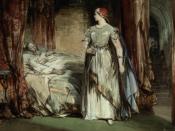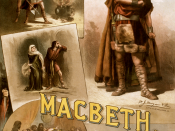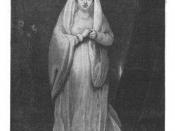Macbeth Essay
I am going to prove that in the play Macbeth, a symbol of
blood is portrayed often(and with different meanings), and that
it is a symbol that is developed until it is the dominating theme
of the play towards the end of it.
To begin with, I found the word 'blood', or different forms
of it forty-two times (ironically, the word fear is used
forty-two times), with several other passages dealing with the
symbol. Perhaps the best way to show how the symbol of blood
changes throughout the play, is to follow the character changes
in Macbeth. First he is a brave honoured soldier, but as the
play progresses, he becomes a treacherous person who has become
identified with death and bloodshed and shows his guilt in
different forms.
The first reference of blood is one of honour, and occurs
when Duncan sees the injured sergeant and says 'What bloody man
is that?'.
This is symbolic of the brave fighter who been
injured in a valiant battle for his country. In the next
passage, in which the sergeant says 'Which smok'd with bloody
execution', he is referring to Macbeth's braveness in which his
sword is covered in the hot blood of the enemy.
After these few references to honour, the symbol of blood
now changes to show a theme of treachery and treason. Lady
Macbeth starts this off when she asks the spirits to 'make thick
my blood,'. What she is saying by this, is that she wants to
make herself insensitive and remorseless for the deeds which she
is about to commit. Lady Macbeth knows that the evidence of
blood is a treacherous symbol, and knows it will deflect the
guilt from her and Macbeth to the servants when she says 'smear
the sleepy...


